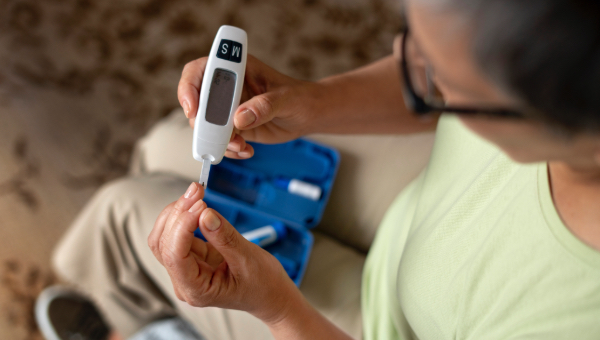Did You Know? You Can Check Your Blood Sugar Yourself in the Comfort of Your Own Home
May 30, 2025
Did You Know? You Can Check Your Blood Sugar Yourself in the Comfort of Your Own Home
Gone are the days when checking your blood sugar meant weekly clinic visits, long waits and anxiety over "white coat syndrome." Thanks to revolutionary technology, tracking your glucose levels is now as simple as scanning a sensor on your arm or pricking your finger at the kitchen table — no lab trip needed.
The Game-Changers: How At-Home Monitoring Works
1. Traditional Glucometers
- How it works: A tiny drop of blood (from a finger prick) + a test strip = instant glucose reading.
- Tech upgrade: Bluetooth syncs data to your phone, creating trend reports.
- Cost: Often covered by insurance; devices start at $25.
2. Continuous Glucose Monitors (CGMs)
- How it works: A coin-sized sensor worn on your arm/abdomen measures glucose every 5 minutes via interstitial fluid.
- No more pricks: Scan with your phone or reader for real-time data.
- Game-changing feature: Alerts for highs/lows before symptoms hit.
- Popular brands: Codefree, Freestyle Libre, Abbott.
Why Home Monitoring is a Health Revolution
- Immediate feedback: See how food, exercise, and stress affect your levels instantly.
- Personalized care: Spot patterns to tailor meals, insulin doses, and activity with your doctor.
- Early warnings: CGMs alert you to dangerous lows overnight or rapid spikes post-meal.
- Peace of mind: Reduce anxiety with constant access to your data.
Busting 3 Common Myths
1. “Only diabetics need this.”
→ Fact: Prediabetics, athletes and biohackers use CGMs for metabolic health insights.
2. “It’s too painful/complicated.”
→ Fact: Modern CGMs are painless to apply. Apps auto-sync data in user-friendly charts.
3. “Insurance won’t cover it.”
→ Fact: Many plans cover CGMs for Type 1, Type 2 and gestational diabetes.
Getting Started: Your 4-Step Plan
1. Talk to your doctor: Discuss if home monitoring suits your health goals.
2. Pick your device: Glucometer for simplicity, CGM for 24/7 insights.
3. Learn your targets: Understand your ideal glucose range (e.g., 70–180 mg/dL).
4. Act on data: Use apps like MySugar or Apple Health to spot trends.
Conclusion
Empowerment begins with knowledge. With today’s tech, understanding your body’s signals is no longer locked behind clinic doors. Whether you’re managing diabetes, prediabetes or just optimizing wellness — your health is now literally in your hands. Visit any of our stores and get your own glucose monitoring machine.
Stay safe and healthy!
Recent Post

Bridging the Nutritional Gap: Understanding the Role and Limits of Supplements

Reclaim Your Focus: The Life-Changing Magic of a Digital Detox

Struggling with Dandruff? Simple Steps to Stop the Flakes!

Wellness Wednesday: Tips to Manage Your Health Better

Did You Know? Cloves Are Antioxidant Powerhouses Essential for Your Health!

Winter Wellness: Your Essential Guide to Thriving Not Just Surviving

Did You Know? Hibiscus Tea Can Help Tame High Blood Pressure

The Overthinking Trap: When Your Mind Becomes Your Worst Enemy

The Health Benefits of Journaling: A Simple Habit for a Healthier Mind and Body

A Beginner’s Guide to Intermittent Fasting

